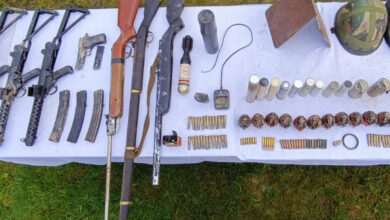
- India exported defence goods worth Rs 8,000 crore in the first half of the current financial year (FY). By 2025, the country hopes to reach an annual export goal of Rs 35,000 crore.
- According to the report, Indian industry also did pretty well, making enough equipment to meet 29.4% of the total need for air defence systems.
Rohit Bedi, who started AROO, India’s first defence startup that makes specialised clothing for the military, says that the government’s “Make in India” programme is the best thing ever.
“Our vision started with the Indian government’s goal of promoting the making of key imported products in India to reduce the country’s reliance on imports,” he says.
The Extreme Cold Weather Clothing System (ECWCS) was the company’s first product. It passed its field test in 2017 and is now being made by its original equipment manufacturer in Bengaluru (OEM).
ECWCS is a three-layer modular clothing system that is made to work in temperatures as low as –50°C. Indian soldiers use it in places with high altitudes, like the Siachen Glacier.
“This clothing set has been brought in from other countries for over 25 years. Bedi says, “We are proud to say that AROO ECWCS is better than the clothing systems that the Indian Army gets from abroad.”
But clothing is just one of many defence products that are made in the country and, over time, find buyers outside of the country. More than 200 companies have been given permission to make military equipment and bid on government contracts, preferably on their own, but if they need to, they can also work with foreign companies.
Foreign direct investment (FDI) has been allowed in the defence sector up to 74 percent through the automatic route and up to 100 percent through the government route, if it means getting access to new technology. Since the notification, a total of Rs 494 crore worth of FDI has been reported until May 2022.
India’s former director general of military operations, Lt Gen Vinod Bhatia (Retd), “Indigenous defence production is a very good step. If you want to be a big power and talk about strategic independence, you need to make your own weapons. India is the only country in the world that gets weapons and ammunition from everywhere: Russia, the US, France, Israel, you name it. Indigenous defence production has been needed for a long time, and it has finally started.”
India exported defence goods worth Rs 8,000 crore in the first half of the current financial year (FY). By 2025, the country hopes to reach an annual export goal of Rs 35,000 crore.
Last month, India’s Defense Minister Rajnath Singh said that the country will aim to export Rs 35,000 crore worth of defence goods every year by the end of FY 2025. Ajay Kumar, who is leaving his job as defence secretary, said that the country’s vision for Amrit Kaal (the next 25 years until India’s 100th year of independence) is to make India one of the top five countries in the world when it comes to making weapons.
Make in India effect
The ambitious Make-in-India project of the government seems to have led to an unexpected export boom in the defence sector. Exports include, among other things, personal protection items, offshore patrol vessels, ALH Helicopters, SU Avionics, coastal surveillance systems, Kavach MoD II launcher and FCS, spare parts for radar, electronic systems, and light engineering mechanical parts.
The Ministry of Defense (MoD) is also looking for other contracts to increase exports of defence products. Some of these are the sale of two military Dornier planes to Sri Lanka and the Light Combat Aircraft (LCA) Tejas. Both planes are made by Hindustan Aeronautics Ltd, which is owned by the government (HAL). India and the Philippines signed a deal in January to sell Brahmos supersonic anti-ship cruise missiles for $375 million.
The department of defence production, ministry of defence, is in charge of 16 Central Public Sector Undertakings (CPSUs), such as BEML, Mazagaon Shipbuilders Ltd, Advanced Weapons and Equipment India Ltd, and Armoured Vehicles Nigam Ltd. (MoD).
More than 50 private Indian companies have helped make defence exports possible. India now sends defence products to 75 countries all over the world, including Italy, France, Chile, and the United States.
“Today, the rest of the world trusts India’s technology because the country’s military has shown how well it works. The INS Vikrant is now part of the Indian Navy’s fleet. The Cochin Shipyard’s own technology was used to make this engineering masterpiece.
The Indian Air Force is using Light Combat Helicopters made as part of the “Make in India” campaign. The Indian Army is also buying field guns made in India. Modern artillery is being built at Hazira to protect the borders of the country. Prime Minister Narendra Modi said this on October 18 when DefExpo 2022 was officially opened in Gandhinagar, Gujarat.
He said that “about 68 percent of India’s defence budget has been set aside for Indian companies.” He also said that “defence forces have made two lists of equipment: one list is for things that can be bought in India, and the other list is for things that can be bought from abroad, if necessary.”
So, 411 items are being bought in the United States.
A mountain to climb
Still, a report on Arms Production Capabilities in the Indo-Pacific Region released by the Stockholm International Peace Research Institute (SIPRI) earlier this month raises “serious doubts about whether India will be able to significantly reduce its reliance on imports in the short and medium term.”
According to the report, 84.3 percent of the major conventional arms India bought between 2016 and 2020 came from other countries. Of those, 57.8 percent came from licenced production. In sharp contrast, only 15.7% of all purchases were made from within the country.
Still, among the five sectors that SIPRI looks at, India’s shipbuilding industry stands out as a great example of the country’s ability to design and build major platforms. Most of the ships made during that time were based on designs from India. So was the ballistic missile submarine Arihant, which was powered by nuclear energy and “gave India’s nuclear forces a high level of autonomy.”
Not surprisingly, 78.6% of the total number of naval vessels bought by the MoD came from the domestic shipbuilding industry. The report said that most people think that further progress will depend on how well the Indian industry can design and make propulsion systems and weapons for ships and submarines.
According to the report, Indian industry also did pretty well, making enough equipment to meet 29.4% of the total need for air defence systems. But it could only meet 6,3% of the total demand for aircraft and 7.7% of the demand for missile systems. The rest of the demand had to be met through direct imports or production under a licence.
SIPRI, however, found in 2021 that India’s arms imports had dropped by 33% between 2011 and 2015 and 2016 and 2020. This was at a time when the country was taking a number of steps to reduce its reliance on imported military hardware. Most of the drop in arms imports was due to an effort to buy less weapons from Russia and make the process of buying them easier.
Lt. Gen. Bhatia thinks that the Indian government needs to do more to help private business and that procedures and processes need to be made even easier. Also, the two Defense Industrial Corridors that are being built in Uttar Pradesh and Tamil Nadu need to move faster.
Reforms are the only way forward. Amit Cowshish, a former financial advisor (acquisition) for the Ministry of Defense, wrote in the Financial Express that people shouldn’t misinterpret the SIPRI 2022 observations as a way to put down Make-in-India.
“The report should lead to an internal reevaluation of how well the MoD’s policies are working and whether any course corrections are needed to reach the goal of self-reliance in defence production,” he said.







Facebook Comments